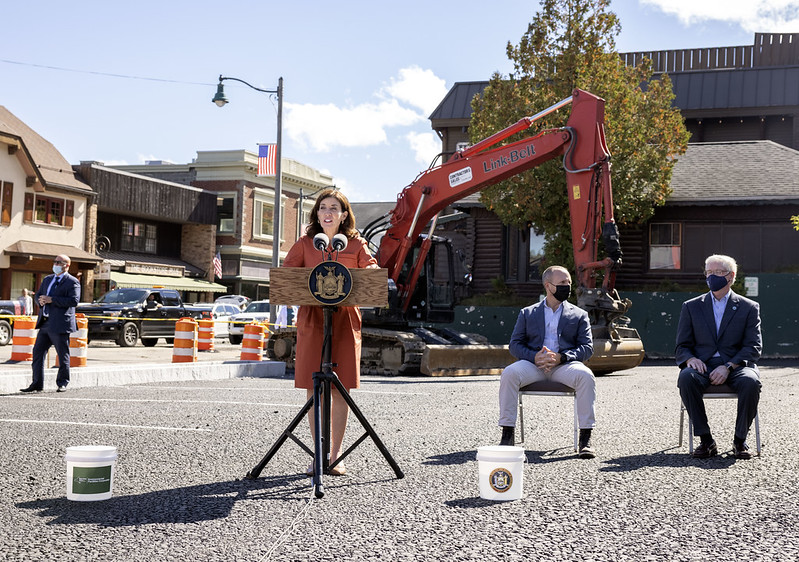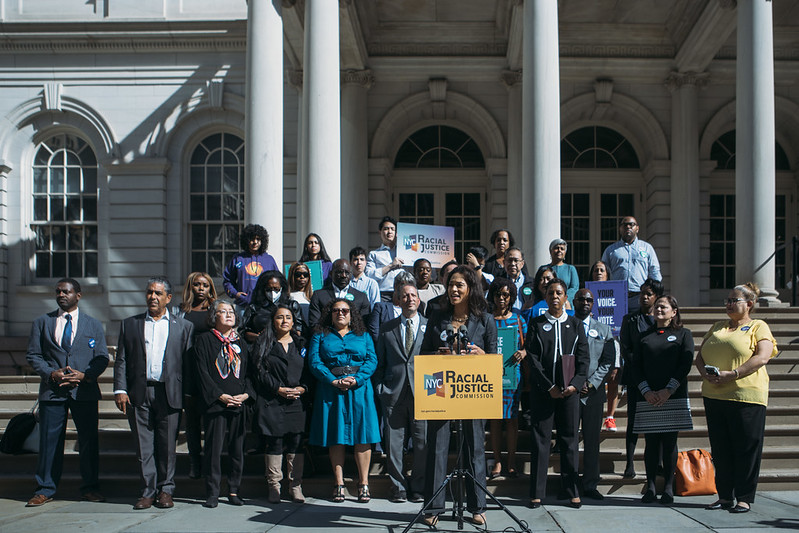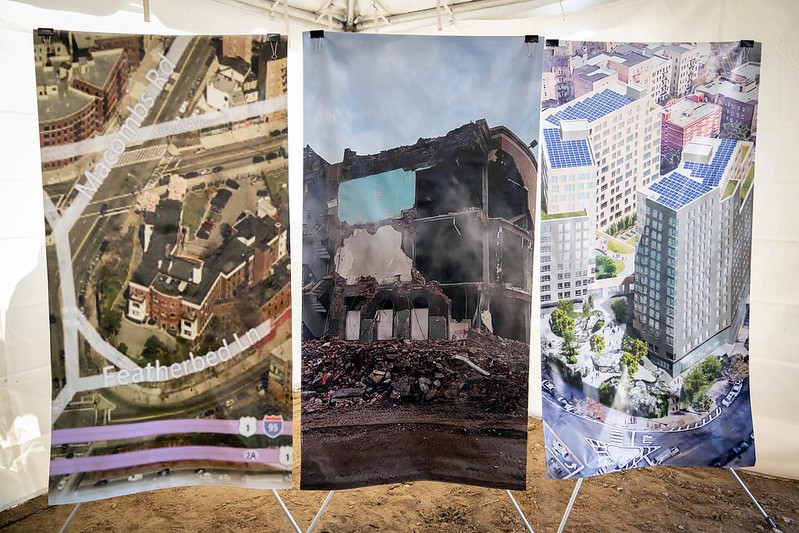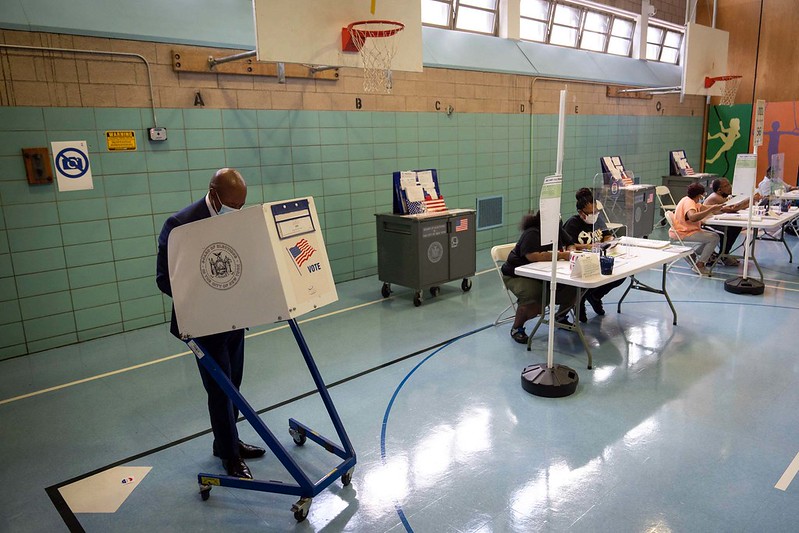National Night Out and Community Policing
The last year has been a difficult one for the New York Police Department: the police shootings of Amadou Diallo and Patrick Dorismond; the subsequent acquittal of the officers involved in the Diallo case; the lack of diplomacy by Commissioner Safir and Mayor Giuliani. All have increased the mistrust that many have felt toward the police for a long time.
But for the past 16 years, something out of the ordinary occurs on the first Tuesday night of August, and this year is no different. It is called National Night Out -- an evening of cooperation, communication, celebration, a series of activities throughout the country and throughout the city including basketball games between precinct teams and community groups, live music, staffed information booths, and magic shows. National Night Out is sponsored by the National Association of Town Watch, the same group that sponsors Neighborhood Watch groups.
The success of National Night Out is irrefutable: Since its founding in 1984, it has grown to involve over 30 million people in more than 9,000 communities. It is part of a growing trend toward community policing - a crime-fighting strategy based on the idea that a strong relationship between the police and the community is the key to lower crime rates. Most frequently, such a relationship is forged by having beat cops patrol the same areas, often on foot, so that area residents come to know their police officers. Other basic strategies of community policing involve outreach programs and community collaboration. Both the National Center for Community Policing and Policing.com offer what amounts to a primer on community policing - - its history, implementation and results.
The NYPD runs a host of programs to involve community residents and respond to their needs. Just last month, a Staten Island prosecutor announced the opening of a community office in Tottenville. The purpose of the field office, District Attorney William Murphy said, is to work more closely with the residents to identify community needs and issues, and "to solve problems before they begin."
Staten Island is not alone. Every precinct in the City has its own programs and community policing unit. Here are just a few examples:
- Auxiliary Police Program. The 111th precinct in Bayside is one of several precincts throughout the city where civilians are trained to be volunteers of the department. Wearing uniforms and patrolling in groups, they act as the eyes and ears of police, often at large community events where security is necessary.
- Model Block Program. Tenants organize block associations to monitor and maintain the quality of their block.
- Precinct Open Houses. This is meant to encourage informal interactions between police and the community.
- Youth Programs. A variety of youth programs are in place across the City, including the "Explorers Program." Open to high schoolers, these Explorers meet once a week at the precinct. Activities range from participating in community functions, such as parades and fairs, to field trips to law enforcement agencies, to rollerblading and athletic activities. During the school year 1998-99, the Explorers program and other youth programs reached over 117,000 youths.
- Domestic Violence Program. The 83rd precinct in Bushwick tracks all domestic violence cases reported. It collaborates with the Victims Service Agency to provide counseling and social services to battered women.
Critics say these programs are little more than a gesture, and that racism and abuse of power persist within the department. The US Commission on Civil Rights released a widely-publicized report in June which found that the NYPD was guilty of racial profiling in its stop-and-frisk practices. Among its recommendations: adopt community policing strategies -- specifically, encourage more officers to live in the areas they police.
The Department of Housing and Urban Development's "Officer Next Door" program is trying to do just that, by offering police officers 50 percent savings on a home that they purchase in designated "revitalization areas" in inner city neighborhoods across the country. There are 53 such areas in New York City. It is unclear as of yet how many officers have taken advantage of the offer.
A recently released report on the New York Police Department's disciplinary actions against officers found that, despite the greater attention brought by the high-profile cases, there was actually a 25 percent drop in the allegations of police brutality last year. Public Advocate Mark Green also produced a report, though with far more damning statistics, entitled Disciplining Police: Solving the Problem of Police Misconduct. Whether the situation of police brutality is getting worse or getting better, many suggest that one way to curtail it is through community policing.
Jessica Green is a student of public policy at Columbia University's Graduate School of International and Public Affairs.
Red Hook Community Justice Center
The defendant, charged with drug possession, walked to the front of the courtroom, her head down, her hands clasped behind her back, as Judge Alex Calabrese peered down at her, and pronounced her sentence: Job training. Community service
"There are a lot of services in this building that could help you," he tells the defendant. " And it's much more likely you won't have to come back here again." He is talking about the Red Hook Community Justice Center.
Opened just last month, the Justice Center is one of a handful of "community courts" across the country that re-envision how the criminal justice system should operate. By offering on-site services -- including drug treatment, G.E.D. classes to get a high school diploma, and job training -- the Center seeks to address the underlying problems that contribute to high crime rates. They also offer soup in the arraignment room.
At the same time, alternative sentences -- such as cleaning up a neighborhood park -- aim to make punishment visible while putting offenders to work in their communities. The Red Hook Justice Center joins the Midtown Community Court, which opened in Manhattan in 1993. A similar court in Harlem will open later this year. All three are designed to address one of the criminal justice system's most glaring failures: those arrested for low-level offences often are back on the streets in a matter of weeks or months, committing crimes.
The case of Paris Drake, a career criminal who had been arrested more than twenty times before allegedly attacking a woman with a brick in broad daylight last winter, highlighted the "revolving door" problem in New York's overburdened courts. Both Governor Pataki and Mayor Giuliani have called for tougher, mandatory sentences for low-level offenders.
More defendants in the Midtown Community Court who are sentenced to community service actually do it than in any other criminal court in the city. Yet there is also a recidivism rate that is as high as those of the other courts. Still, community court supporters say the push for reform, spearheaded by New York State Chief Judge Judith S. Kaye, is building. "This language of rethinking and improving business as usual is starting to seep out," says Greg Berman, one of the Red Hook Justice Center's planners. "It's not just us."
In Red Hook, changing business as usual meant not just improving the criminal justice system, but tackling a host of other quality-of-life issues within the community. Later this year, the Justice Center will add housing and family court cases, making it the country's first multi-jurisdictional court. The Red Hook Public Safety Corps, an Americorps program housed within the Center, has already become one of the neighborhood's biggest employers. The Center's services are available not only to offenders but also to local residents who may have no connection to the criminal justice system.
"The notion of bringing courts back to the community, that courts can play a role in making communities safer, stronger-these are notions that resonate with people," says Berman, Deputy Director of the Center for Court Innovation (CCI), a joint project of the state court system and the non-profit agency, the Fund for the City of New York.
Berman and other planners at CCI began work on the Red Hook Justice Center in 1994, meeting with community members and using the Midtown Community Court as a model. Many of the Justice Center's innovations are literally built into the building. The detention rooms, for instance, where people are held before they are brought to trial, use plate-glass windows instead of bars to allow natural light to enter.
"We felt that the building's design should reflect the principles of the program," says Berman. "We want to communicate respect for people."
Judge Calabrese says his colleagues within the judiciary wish they had the services available to him in sentencing offenders. He cites the case of a sixteen-year-old high-school dropout who appeared before him, arrested for possession of four vials of crack.
"I thought he was someone on the wrong path," said Judge Alex Calabrese. "He was working with a drug dealer, starting to make some money, and it's tough to compete with that." As part of his sentence, the young man began job training, attending GED classes, and talking to a counselor who had worked for twenty years at the state prison in Attica. "This counselor makes a very convincing argument that drugs will land you in prison in the long run.
"I think this case would've been handled very quickly downtown. They would've addressed the charge, but they wouldn't address the underlying problem. He would've gotten his jail sentence and he'd probably get out and go back to working with a dealer. I don't think he could've been straightened out."
Â
NYPD vs. Civil Rights Commission
The battle over police practices in New York is now being waged on paper. On April 27, one year after it first announced its investigation of the NYPD, the U.S. Civil Rights Commission released a much anticipated 250-page draft report. The Police Department weighed in on May 16 with an angry 700-page rebuttal.
The Commission faults the NYPD for inadequate diversity training and failed minority recruiting efforts, but its most serious charge is that police officers use racial profiling in their stop-and-frisk tactics. The report cites the Department's own records, which show that in Staten Island, for example, 51% of the people stopped in 1998 were black, though blacks make up only 9% of the borough's population.
The report dismisses the Department's claims that stop-and-frisks occur most often in high-crime, minority neighborhoods, and that officers are simply responding to descriptions of suspects as reported to them. After reviewing nearly 150,000 records of stops made in 1998, the Commission determined that officers usually acted on their own judgments and observations, rather than victim identifications.
In its rebuttal, the NYPD disparages the report as "an unfortunate exercise in shoddy reporting" and "an embarrassment to the United States government." In particular, the Department ridicules the Commission's reliance on perennial police critics Al Sharpton and the New York Civil Liberties Union's Norman Siegel. Mayor Giuliani has called the report "a political operation of the Democratic Party," neatly timed to give Hillary Clinton a boost for her Senate run. (The Commission consists of an eight-member panel of four Democrats, three independents, and one Republican. The New York Observer has reported that the head of the Commission's head, Mary Frances Berry, has made campaign contributions to Hillary.
Jerome Sounds Off:
For all the controversy it has created, the Civil Rights Commission report contains little that New Yorkers haven't heard before. In restrained language, bolstered by numerous charts and citations of hundreds of thousands of documents reviewed by its panel, the report makes some familiar accusations, but also pats the NYPD on the back in several instances.
The Commission offers some remedies that are unrealistic (officers should live in the City) or ill-begotten (the elitist proposal that officers be required to have four-years of college instead of two because better-educated officers are less likely to engage in misconduct). Another recommendation, the formation of an independent monitor to review civilian complaints of police misconduct, would in effect create a second oversight agency to monitor the Civilian Complaint Review Board.
The Commission finally gets it right when it discusses the pressure felt throughout the NYPD„from Commanding Officers to beat cops„to produce arrests. Could it be that if the Department eases up on quotas to make collars and stands down the armies of Operation Condor personnel, it will help defuse the issue of police misconduct? It may be wishful thinking, but the Mayor's newest resolution to reach out to all the City's residents may give his administration one last chance to find out.
Jerome Chou is a freelance writer. He works part-time interviewing recently released ex-offenders about their re-entry into society.




